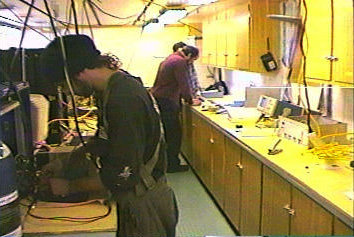13 April, 1999
Dear Friends:
Today we showed up early at the Antarctic Support Agencies warehouse on the
port docks to be outfitted.
Here we tried on the survival gear known as ECW – Extreme Cold Weather
gear – and ensured a proper
fit and verified the conditions of the gear that might save our lives. We
were also given the opportunity to
request various optional accessories…as though a lifetime Floridian would
know what additional
equipment he needed to survive the cold! I asked for everything!
After outfitting here, we went on to the boat and I unloaded the weather
station which my students had
built. It had suffered minor shipping damages, losing the anemometer and
conductivity sensors. I was
given use of a shipping container (the railroad boxcar kind that you may
see on trains, trucks or container
vessels) that had been outfitted with power, heat, lights, and a workbench
and more tools than a guy could
dream of! The rest of the day was spent rounding up materials to prepare
to further weather-proof the box,
attach it to the deck railing, and bring it online.
After the day wound down, I brought my gear from the hotel to the ship for
my first night aboard. It was
very quiet as most had elected to stay the final night in the hotel Jose
Noguiera.
I saw for the first time in my life literally thousands of celestial
objects I had never seen before…the suns
of the southern hemisphere…I brought my star charts on advice from a
previous TEA…Thanks Kim!
Another friend asked if I could still see Orion…Yes! There he was, hanging
low over the western sky, but
for a brief moment, like a watchman from my northern abode…
We are in port with a damaged UPS system – Uninterruptible power supply –
necessary to have smooth
electricity for the computers. We have engineers working night and day
trying to get it fixed (this ship
costs $30,000-$40,000 per day to sit in port). Think of that and the fact
that the research teams each have
electrical engineers and software engineers still soldering hardware and
writing programs like crazy before
we get to the research site. I guess everyone feels that they can make
their equipment just a little better,
including myself, having spent the day preparing to weather-proof the
weather station that my Turner
students built, and lengthening the cable (I’m working out of a cargo
container that has electricity – it’s
basically a railroad car minus the wheels).
I’m still in Chile, but it’s so cold that there is ice on the deck. Punta
Arenas is basically the end of the earth.
It warms up to the 50’s these waning summer days, but by the end of the
day, the clouds have pushed their
way over the Andes and an icy, disrespectful wind cuts through your clothes
and chills you to the bones.
I’m now sitting up with the engineers, the night before we steam out of
port, away from the security of any
supply store (and we’ve visited them frequently, for this or that, a
transformer, a plug, an adapter, all
through faulty spanish…), trying to get a digital signal through 900 meters
of cable, all of which will be
reeled out to lower the probe into the deepest depths. These guys know
that the rest of the cruise, at tens of
thousands of dollars per day relies on their making their theories work in
the real world, the world of salt,
sea, winds, strains, and probabilities….
At 1 AM in the morning, they get their answer: an electronic ping sent
down 3000 feet of cable is echoed
back by the circuit they’ve designed, months, years before, like a voice
from the darkness….they know
now that they will succeed, though few know of the hours, the sweat, the
fear, the tenderness with which
they’ve handled pounds of delicate circuits…
When it is time, they will flip switches and see lights, numbers, figures
from their chalkboards and
notebooks, abstractions turned into reality by sheer will, imagination, and
dedication, enabling them to
carry on their measurements, to gain numbers and measurements from remote,
inaccessible places.

Franz, the team biologist, tying down computer equipment in the foreground while John and Joe, the engineers work to get the analytical sled online.
Contact the TEA in the field at
.
If you cannot connect through your browser, copy the
TEA's e-mail address in the "To:" line of
your favorite e-mail package.
|
